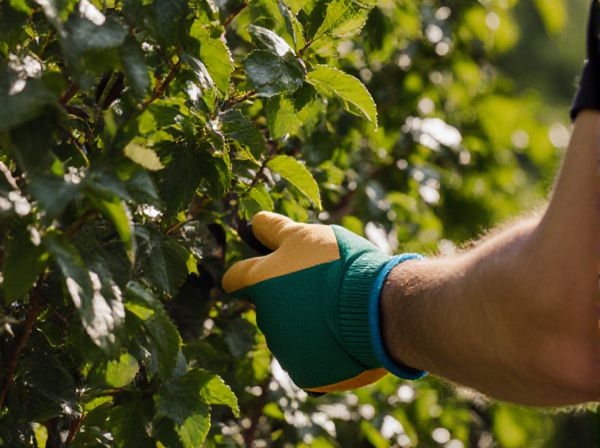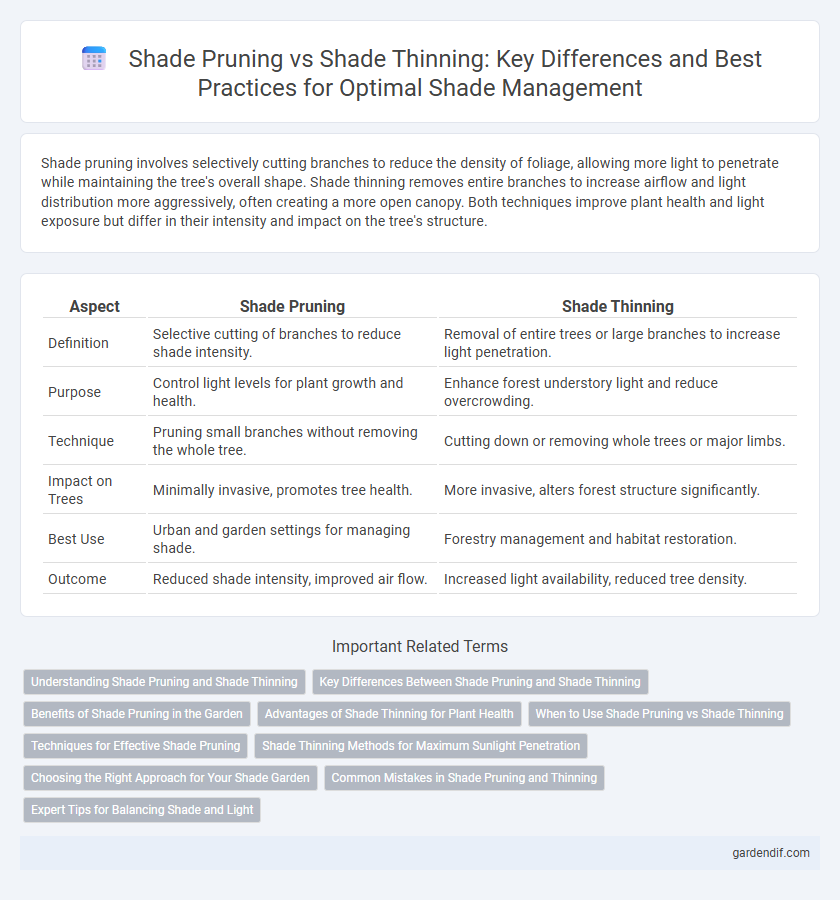
shade pruning vs shade thinning Illustration
Shade pruning involves selectively cutting branches to reduce the density of foliage, allowing more light to penetrate while maintaining the tree's overall shape. Shade thinning removes entire branches to increase airflow and light distribution more aggressively, often creating a more open canopy. Both techniques improve plant health and light exposure but differ in their intensity and impact on the tree's structure.
Table of Comparison
| Aspect | Shade Pruning | Shade Thinning |
|---|---|---|
| Definition | Selective cutting of branches to reduce shade intensity. | Removal of entire trees or large branches to increase light penetration. |
| Purpose | Control light levels for plant growth and health. | Enhance forest understory light and reduce overcrowding. |
| Technique | Pruning small branches without removing the whole tree. | Cutting down or removing whole trees or major limbs. |
| Impact on Trees | Minimally invasive, promotes tree health. | More invasive, alters forest structure significantly. |
| Best Use | Urban and garden settings for managing shade. | Forestry management and habitat restoration. |
| Outcome | Reduced shade intensity, improved air flow. | Increased light availability, reduced tree density. |
Understanding Shade Pruning and Shade Thinning
Shade pruning involves selectively removing entire branches to reduce canopy density and allow more light penetration, promoting healthy growth and improved air circulation. Shade thinning targets smaller, less essential branches to decrease shade without altering the tree's overall structure, enhancing light distribution while maintaining natural form. Understanding these techniques helps optimize plant health, ensuring balanced light exposure and minimizing stress from excessive shading.
Key Differences Between Shade Pruning and Shade Thinning
Shade pruning primarily involves selectively removing lower branches and dense foliage to increase light penetration and air circulation within a tree's canopy, promoting healthier growth. Shade thinning targets the reduction of overall crown density by selectively removing interior branches and small twigs, aiming to reduce shade on understory plants while maintaining the tree's natural shape. The key difference lies in pruning focusing on branch removal for structural improvement, whereas thinning emphasizes light management and ecological balance.
Benefits of Shade Pruning in the Garden
Shade pruning in the garden enhances plant health by selectively removing dense branches, allowing more sunlight to penetrate and improving air circulation. This targeted approach reduces the risk of fungal diseases while promoting robust growth and flowering. Unlike shade thinning, shade pruning maintains the tree's natural form, creating a balanced canopy that supports both aesthetic appeal and ecological function.
Advantages of Shade Thinning for Plant Health
Shade thinning improves air circulation and light penetration, reducing fungal diseases and promoting stronger, healthier plant growth. It allows selective removal of branches to maintain structural integrity and minimize stress, enhancing overall plant vitality. This method supports photosynthesis efficiency, leading to more robust foliage and improved resistance to environmental stressors.
When to Use Shade Pruning vs Shade Thinning
Shade pruning is most effective when the goal is to selectively remove branches to direct sunlight into specific areas, enhancing light penetration without significantly opening the canopy. Shade thinning should be used when uniform light distribution is needed throughout the tree or landscape, involving the removal of smaller branches to reduce density and increase airflow. Choosing between shade pruning and thinning depends on the desired light intensity and canopy aesthetics, with pruning targeting targeted light control and thinning promoting overall canopy health.
Techniques for Effective Shade Pruning
Shade pruning involves selectively cutting branches to reduce canopy density, enhancing light penetration and air circulation, which promotes healthier plant growth and prevents diseases. Shade thinning removes entire branches or stems at the base, creating larger gaps in the canopy, improving overall tree structure and stability. Effective shade pruning employs precise cuts at branch junctions and seasonal timing to optimize growth responses while minimizing stress on the plant.
Shade Thinning Methods for Maximum Sunlight Penetration
Shade thinning methods enhance sunlight penetration by selectively removing branches that block light, promoting healthier growth and improved air circulation. Unlike shade pruning, which targets specific limbs for structural balance or aesthetics, shade thinning focuses on reducing canopy density to maximize light availability for understory plants. Techniques such as directional thinning and selective limb removal optimize light distribution while maintaining the tree's natural shape and vigor.
Choosing the Right Approach for Your Shade Garden
Shade pruning involves selectively removing branches to reduce canopy density and increase light penetration, crucial for delicate shade plants requiring filtered sunlight. Shade thinning focuses on strategically removing entire branches to open the canopy, enhancing air circulation and preventing fungal diseases common in dense shade gardens. Choosing the right approach depends on plant species, garden layout, and desired light levels, ensuring optimal growth and health for your shade garden.
Common Mistakes in Shade Pruning and Thinning
Common mistakes in shade pruning include over-pruning, which reduces leaf area essential for photosynthesis, and improper timing that stresses trees during critical growth periods. Shade thinning often errs by removing too many branches, resulting in increased sunlight exposure that can damage shade-tolerant plants. Both practices require careful assessment to maintain canopy density and promote healthy tree structure.
Expert Tips for Balancing Shade and Light
Shade pruning targets the removal of larger branches to significantly reduce dense canopy areas, allowing substantial sunlight penetration while maintaining overall tree health. Shade thinning strategically eliminates smaller, selective branches to increase light and air flow without drastically altering the tree's natural shape, promoting balanced growth. Experts recommend combining both methods to optimize light distribution and shade quality, enhancing photosynthesis and reducing fungal risks.
shade pruning vs shade thinning Infographic

 gardendif.com
gardendif.com